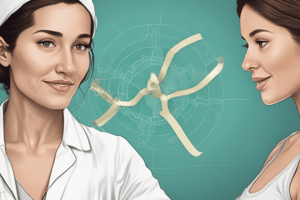Podcast
Questions and Answers
What is the primary cause of cervical cancer?
What is the primary cause of cervical cancer?
- Smoking
- Human Papillomavirus (HPV) infection (correct)
- Family history of cervical cancer
- Weakened immune system
What is the purpose of a Pap test?
What is the purpose of a Pap test?
- To remove a sample of cervical tissue
- To examine the cervix and vagina
- To detect HPV infection
- To detect abnormal cells in the cervix (correct)
What is the symptom of advanced cervical cancer?
What is the symptom of advanced cervical cancer?
- Abnormal vaginal bleeding
- Pelvic pain or discomfort
- Unusual vaginal discharge
- All of the above (correct)
What is the purpose of a colposcopy?
What is the purpose of a colposcopy?
What is Stage 0 of cervical cancer?
What is Stage 0 of cervical cancer?
What is a prevention method for cervical cancer?
What is a prevention method for cervical cancer?
What is a risk factor for cervical cancer?
What is a risk factor for cervical cancer?
What is a treatment method for cervical cancer?
What is a treatment method for cervical cancer?
What is the benefit of quitting smoking?
What is the benefit of quitting smoking?
What is the purpose of a biopsy?
What is the purpose of a biopsy?
Flashcards are hidden until you start studying
Study Notes
What is Cervical Cancer?
- Cervical cancer is a type of cancer that occurs in the cervix, the lower part of the uterus that connects to the vagina.
- It occurs when abnormal cells in the cervix grow and multiply uncontrollably, forming a tumor.
Causes and Risk Factors
- Human Papillomavirus (HPV) infection: HPV is the primary cause of cervical cancer, with certain types of HPV (HPV 16 and 18) being high-risk.
- Other risk factors:
- Weakened immune system
- Early sexual activity
- Multiple sexual partners
- History of sexually transmitted infections (STIs)
- Family history of cervical cancer
- Smoking
Symptoms
- Early stages: often asymptomatic
- Advanced stages:
- Abnormal vaginal bleeding (e.g., between periods, after sex, or after menopause)
- Pelvic pain or discomfort
- Unusual vaginal discharge
- Pain during sex
Screening and Diagnosis
- Pap test: a routine screening test to detect abnormal cells in the cervix
- HPV test: a test to detect HPV infection
- Colposcopy: a procedure to examine the cervix and vagina using a special microscope
- Biopsy: a procedure to remove a sample of cervical tissue for further examination
Stages
- Stage 0: carcinoma in situ (abnormal cells in the cervix that have not invaded deeper tissues)
- Stage I: cancer is confined to the cervix
- Stage II: cancer has spread to the vagina or parametrium (tissue surrounding the cervix)
- Stage III: cancer has spread to the pelvic wall or vagina
- Stage IV: cancer has spread to distant organs (e.g., bladder, rectum, or distant lymph nodes)
Treatment
- Surgery: removal of the cervix, uterus, or surrounding tissues
- Radiation therapy: uses high-energy radiation to kill cancer cells
- Chemotherapy: uses drugs to kill cancer cells
- Combination therapy: a combination of surgery, radiation, and chemotherapy
Prevention
- HPV vaccination: protects against high-risk HPV types
- Regular Pap tests and HPV tests: early detection and treatment of abnormal cells
- Safe sex practices: using condoms and limiting the number of sexual partners
- Quitting smoking: reduces the risk of cervical cancer
Studying That Suits You
Use AI to generate personalized quizzes and flashcards to suit your learning preferences.




